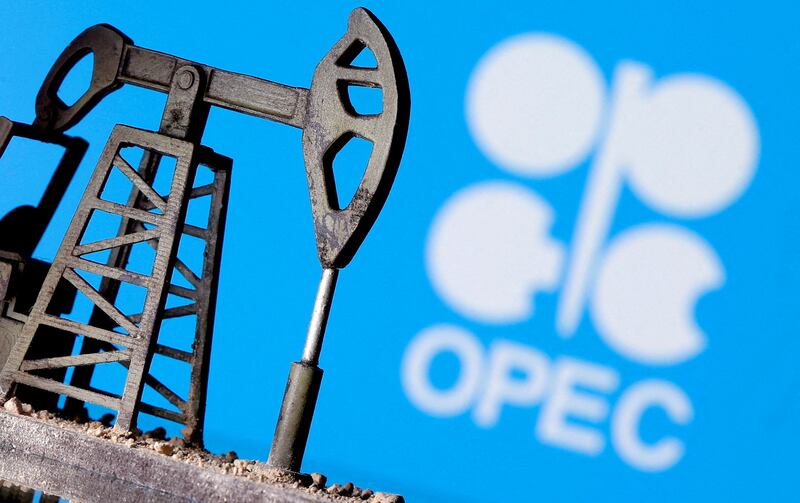Opec has stuck to its 2023 growth projection for oil demand, although the oil producers’ group has slightly lowered its forecast for regions other than China.
Oil demand in Organisation for Economic Co-operation and Development (OECD) countries was lowered due to economic headwinds, which was offset by improvement in Chinese demand growth projects.
“Minor upward adjustments were made due to the better-than-expected performance in China’s economy, while other regions are expected to see slight declines, due to economic challenges that are likely to weigh on oil demand,” Opec said in its monthly market report on Thursday.
The world crude demand growth forecast for 2023 “remains the same as [the] previous month’s assessment” at 2.3 million barrels per day with the OECD countries increasing by 0.07 million bpd and non-OECD countries growth at close to 2.3 million bpd, Opec said.
Total world oil demand is expected to reach 101.9 million bpd in 2023.
“However, this forecast is subject to many uncertainties, including global economic developments and ongoing geopolitical tensions,” Opec said.
In China, oil demand rebounded by 1.4 million bpd year on year in March, up from a “healthy growth” of 0.9 million bpd in February.
“The strong rebound in economic and social activity amid feedstock requirements for the petrochemical sector supported oil product demand,” Opec said.
China, the world’s second-largest economy and top crude importer, reopened its borders in January after enforcing a strict zero-Covid policy for about three years.
The Asian country is aiming for gross domestic product growth of 5 per cent this year, after growing by 3 per cent last year.
China's March purchasing managers' index showed that the manufacturing sector declined slightly, but is still within the expansionary trajectory at 50 points, slightly below 51.56 points in February.
Similarly, the March services PMI shows that the services sector is performing very well, moving up to 57.8 points in the month, from 55 in February and reflecting the reopening of the country from lockdown, Opec said citing the latest data.
Joe Biden responds to Opec oil cuts

In March, Opec secretary general Haitham Al Ghais said he was “cautiously optimistic” about China's reopening but added that a slowdown in the US and the EU could dampen crude demand this year.
“There is phenomenal demand growth in Asia [but] what concerns us more is actually the slowdown we see in Europe and the US in terms of the financial situation [and] inflation,” Mr Al Ghais said at the CeraWeek energy conference in Houston.
“We see a kind of a divided market … one market with promising growth [and] the other side with a slowdown.”
In February, Goldman Sachs estimated the reopening of China’s economy and a full recovery in the country's domestic demand will be a boon to the global economy, boosting world GDP by about 1 per cent in 2023 and lead to a rally in oil prices.
Oil prices shot up after the Opec+ alliance members last month moved to voluntarily and collectively reduce production by more than one million bpd.
They have momentum in volatile trade since then on global crude demand worries.
Brent, the benchmark of more than two thirds of the world’s oil, was trading 1.31 per cent lower at $75.41 per barrel at 5.41pm UAE time. West Texas Intermediate, which tracks US crude, was down 1.42 per cent at $71.53 a barrel.
In April, the Opec+ alliance of 23 oil producers agreed to stick to oil output cuts after the surprise move of nine of its members.
Producers including Saudi Arabia, the UAE, Iraq, Kuwait, Oman and Algeria said they will implement voluntary oil production cuts of 1.16 million bpd from May until the end of the year.
Russia has also said the 500,000 bpd cut it is introducing from March to June would continue until the end of the year.
The precautionary measure is aimed at supporting the stability of the oil market, the alliance said at the time.
Opec on Thursday kept its global economic growth forecast unchanged at 2.6 per cent for 2023, after expanding an estimated 3.3 per cent in 2022.
It expects the world economy to continue growing this year, albeit at a slower pace.
“As expected, growth [in the first quarter in 2023] was confirmed to have been steady in the US and the eurozone, while the positive effects of China’s reopening, and a firm economic growth trend in India and other Asia, continue supporting global economic growth,” Opec said.
But it expects growth in OECD countries to slow this year.
In emerging markets, China’s reopening has led to “accelerated growth since the beginning of the year, while India’s momentum so far [in the first half of 2023] has been strong, helped by government-led spending plans and income tax cuts, among other measures”, the Opec report said.
The turbulence in recent weeks, triggered by a banking sector crisis in the US and Europe, has stoked worries in capital markets. It has also raised questions about financial stability in light of the inflation-driven monetary tightening cycle.
While US banking sector-related uncertainties remain, further challenges in other areas of the financial sector could also arise, the report said.
“Upside potential may come from less accentuated inflation, providing central banks with room for accommodative monetary policy towards the end of the year,” it added.







